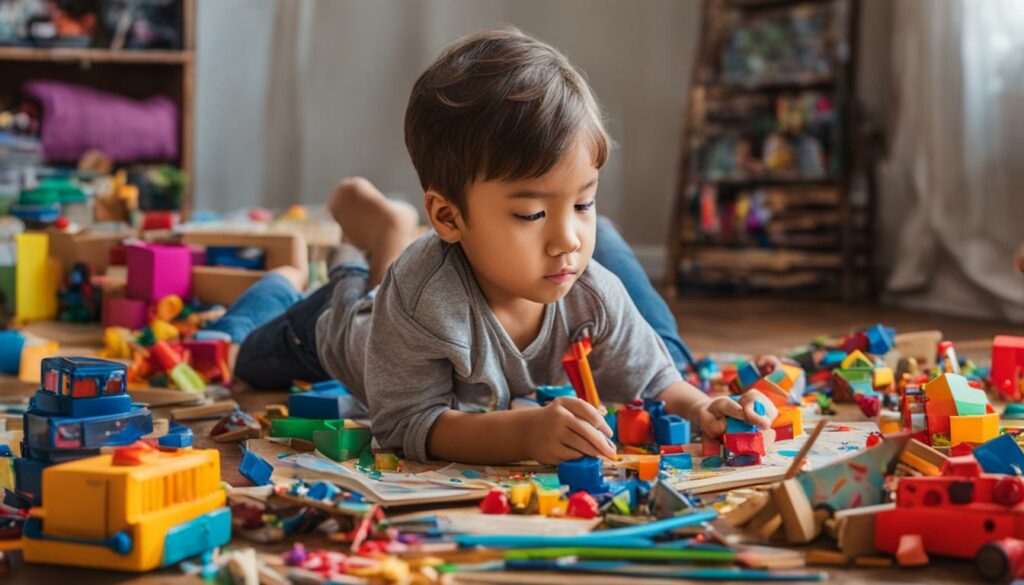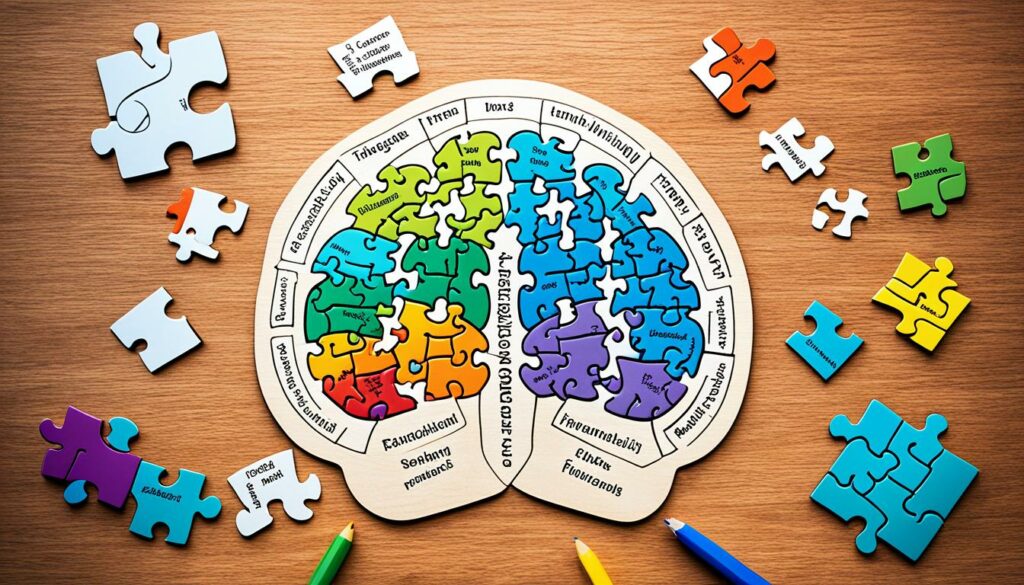Do you ever wonder if your child’s behavior is just typical kid stuff or something more? Are you concerned about their ability to concentrate, follow instructions, or control their impulses? As a parent, it’s important to be aware of the signs and symptoms of ADHD, so you can provide the necessary support and guidance for your child.
Key Takeaways:
- ADHD symptoms can be divided into inattentive and hyperactive-impulsive behaviors.
- Children with ADHD may exhibit a combination of both sets of symptoms.
- ADHD can affect a child’s ability to concentrate, follow instructions, and control impulses.
- Early recognition and intervention can help children with ADHD manage their symptoms and improve daily functioning.
- Consulting with professionals, such as pediatricians and psychologists, is important for an accurate diagnosis and appropriate treatment.
What Is ADHD?
ADHD, or attention-deficit hyperactivity disorder, is a condition that affects a child’s ability to concentrate, pay attention, sit still, follow directions, and control impulsive behavior. Children with ADHD exhibit these behaviors more frequently than other children their age, which can make it difficult for them to meet expectations at school and can lead to conflicts at home and difficulty in social interactions.
ADHD Symptoms
ADHD symptoms can vary in children, but they typically fall into two categories: inattentive behaviors and hyperactive and impulsive behaviors. It’s important for parents and caregivers to be aware of these symptoms in order to recognize and understand ADHD in children.
Inattentive ADHD Symptoms:
- Making careless mistakes
- Being easily distracted
- Difficulty following instructions
- Trouble organizing tasks and belongings
- Forgetting and losing important items
Hyperactive and Impulsive ADHD Symptoms:
- Fidgeting or squirming
- Excessive running and climbing
- Trouble playing quietly
- Impatience and difficulty waiting their turn
- Excessive talking and interrupting others
It’s worth noting that children with ADHD often exhibit a combination of both inattentive and hyperactive/impulsive symptoms. The severity and frequency of these symptoms may vary from child to child. If you notice any of these behaviors in your child, it may be worth discussing your concerns with a healthcare professional who can provide a proper evaluation and diagnosis.
| Inattentive Symptoms | Hyperactive and Impulsive Symptoms | |
|---|---|---|
| 1. | Making careless mistakes | Fidgeting or squirming |
| 2. | Being easily distracted | Excessive running and climbing |
| 3. | Difficulty following instructions | Trouble playing quietly |
| 4. | Trouble organizing tasks and belongings | Impatience and difficulty waiting their turn |
| 5. | Forgetting and losing important items | Excessive talking and interrupting others |
How Are ADD and ADHD Different?

ADD, or attention-deficit disorder, is a term used to describe the same condition as ADHD. The term ADD was commonly used before the word “hyperactivity” was added to the diagnosis in 1987. Some people still use the term ADD to refer to children with ADHD who are not hyperactive. It is important to recognize that ADHD can affect children who are not hyperactive and exhibit primarily inattentive symptoms.
“ADHD is a spectrum disorder, and the symptoms can manifest differently in each individual. Some children with ADHD may predominantly show inattentive symptoms, while others may exhibit hyperactivity and impulsiveness. It is essential for parents and caregivers to understand that both ADD and ADHD fall under the same condition, with ADD referring to the inattentive presentation of the disorder.”
Similarities and Differences between ADD and ADHD
While ADD and ADHD are similar in their underlying condition, they differ in the specific symptoms exhibited. Here are the key differences:
| ADD | ADHD |
|---|---|
| Predominantly inattentive symptoms | Inattentive symptoms and hyperactive/impulsive symptoms |
| Difficulty sustaining focus | Difficulty sustaining focus and increased activity levels |
| Tendency to daydream or seem “spaced out” | Restlessness and excessive energy |
| May appear shy or withdrawn | May be seen as disruptive or hyperactive |
It is important to note that ADD is an outdated term and is no longer used as a separate diagnosis. The diagnosis now includes the various presentations of ADHD, which can include predominantly inattentive symptoms without hyperactivity. Identifying the specific symptoms experienced by a child is crucial in understanding their unique needs and providing appropriate support and intervention.
Can a Child Who’s Not Hyperactive Have ADHD?
Yes, it is possible for a child who doesn’t exhibit hyperactive behavior to still have ADHD. Inattentive ADHD, also known as ADHD without hyperactivity, is a subtype of ADHD where children struggle primarily with inattention rather than hyperactivity and impulsivity. These children may go unnoticed or undiagnosed for longer because their symptoms are less disruptive and may not draw the attention of teachers and parents.
Girls, in particular, can present with symptoms of ADHD that are different from the stereotypical image of a hyperactive boy. They may exhibit more internal symptoms, such as daydreaming or difficulty staying organized, which can be easily overlooked or mistaken for other issues. As a result, girls with ADHD may go undiagnosed for longer periods, preventing them from receiving the support and intervention they need.
If you suspect that your child is struggling with attention-related issues, it is important to seek a professional diagnosis from a healthcare provider or a specialist in ADHD. They will perform a comprehensive evaluation that considers the child’s behavior in various settings, gathers information from multiple sources, and assesses for the presence of ADHD symptoms. Early diagnosis and intervention can make a significant difference in managing ADHD and improving a child’s overall functioning.
“Inattentive ADHD, also known as ADHD without hyperactivity, is a subtype of ADHD where children struggle primarily with inattention rather than hyperactivity and impulsivity.”
ADHD Symptoms in Girls
ADHD symptoms can manifest differently in girls compared to boys. While boys often display more externalized symptoms, such as hyperactivity and impulsivity, girls with ADHD may present with more internalized symptoms, making diagnosis and identification more challenging. Here are some common ADHD symptoms in girls:
- Difficulty maintaining focus and attention
- Daydreaming or being easily distracted
- Trouble staying organized and managing time
- Forgetfulness or forgetful behavior
- Emotional sensitivity and mood swings
- Low self-esteem and feelings of inadequacy
Differences Between Inattentive ADHD and Hyperactive ADHD
| Inattentive ADHD | Hyperactive ADHD |
|---|---|
| Difficulty sustaining focus and attention | Excessive fidgeting or restlessness |
| Easily distracted or spaced-out | Runs and climbs excessively |
| Trouble following instructions or completing tasks | Excessive talking and interrupting others |
| Poor organizational skills | Impulsive decision-making |
| Forgetfulness and losing objects | Difficulty playing and waiting patiently |
If you suspect that your child, especially girls, may have ADHD, consult with a healthcare professional who specializes in ADHD diagnosis and treatment. Remember that ADHD is a neurodevelopmental disorder that can affect individuals of all genders and ages, and early intervention can significantly improve a child’s quality of life.
Why Can Kids With ADHD Concentrate on Some Things? What Is ADHD Hyperfocus?

Kids with ADHD have the remarkable ability to concentrate intensely on certain activities that are highly stimulating or rewarding to them, such as video games. This phenomenon is known as ADHD hyperfocus. When kids with ADHD hyperfocus, they become completely absorbed in the task or activity, often losing track of time and disregarding their surroundings.
This intense concentration can make it challenging for them to shift their attention to less stimulating tasks, such as homework or chores. They may struggle with transitioning between activities, causing frustration and conflicts in their daily lives.
ADHD hyperfocus can be both a blessing and a curse. On one hand, it allows kids with ADHD to excel in areas that capture their interest and passion. They can demonstrate impressive skills and knowledge in these areas, surprising those around them. However, on the other hand, hyperfocus can also lead to difficulties in prioritizing tasks, managing time, and completing responsibilities that may not be as engaging.
In a study conducted by Smith and colleagues (2019), it was found that children with ADHD exhibited longer durations of hyperfocus when engaged in video games compared to their typically developing peers. Video games provide a high level of stimulation, reward, and immediate feedback, making it particularly captivating for kids with ADHD.
While hyperfocus can be beneficial in certain situations, it is important for parents and educators to help children with ADHD develop strategies to manage and regulate their attention. Balancing the engagement of hyperfocus with the necessary demands of daily life is crucial for their overall well-being and success.
Cultivating a Balanced Approach
To support children with ADHD’s ability to concentrate effectively, it is essential to provide a structured environment that encourages task completion and prioritization. Here are a few strategies to promote a balanced approach:
- Break tasks into smaller, more manageable steps
- Set clear expectations and time limits for activities
- Use visual aids and timers to help with transitions
- Encourage regular breaks and physical activity
By implementing these strategies, children with ADHD can learn to harness their hyperfocus while also developing important skills to navigate less stimulating tasks in their daily lives.
What Is Executive Functioning?

Executive functioning plays a critical role in our ability to accomplish tasks effectively. It encompasses a set of self-regulating skills that enable individuals to plan, organize, make decisions, shift between situations, control emotions, and learn from past mistakes. It is like the CEO of our brain, managing and coordinating cognitive processes.
For children with ADHD, executive functioning skills can be impaired, presenting challenges in various areas of their lives. Difficulties with organization, time management, and staying on task are commonly associated with deficits in executive functioning. These children may struggle with setting goals, breaking tasks into manageable steps, prioritizing, and maintaining focus.
Executive functioning skills are essential for success in school, work, and everyday life.
The image above depicts a child engaging in activities that require executive functioning skills, such as planning, organizing, and problem-solving.
It’s important for parents, teachers, and caregivers to provide support and strategies to help children with ADHD develop and strengthen their executive functioning skills. By teaching effective planning strategies, providing organizational tools, and implementing routines and structure, we can empower these children to thrive academically and in their daily lives.
Common Executive Functioning Challenges in Children with ADHD
| Executive Functioning Skill | Challenges |
|---|---|
| Planning and Organization | Difficulty setting goals, coming up with strategies, and organizing activities or materials. |
| Time Management | Struggles with estimating time, staying on schedule, and meeting deadlines. |
| Working Memory | Difficulty holding information in mind and using it to complete tasks. |
| Flexibility | Resistance to change, difficulty adapting to new situations or handling unexpected events. |
| Self-Control | Impulsivity, emotional reactivity, and difficulty managing frustration or anger. |
Understanding the specific executive functioning challenges faced by children with ADHD allows us to tailor interventions and support strategies to their needs. By providing the necessary tools and guidance, we can help these children navigate their daily tasks and build the executive functioning skills essential for their success.
Does ADHD Affect Kids Outside of School?
ADHD can have a significant impact on a child’s daily life beyond the classroom. It can affect their relationships, social interactions, and overall family dynamics. Let’s explore how ADHD manifests in various aspects of a child’s life.
ADHD and Relationships
Children with ADHD may face challenges in making and maintaining friendships. The impulsivity and difficulty in following social norms can lead to misunderstandings and conflicts with peers. They may struggle with taking turns, listening attentively, and respecting personal boundaries. Building and sustaining friendships require social skills that can be compromised by ADHD symptoms.
In addition, children with ADHD may find it difficult to establish close relationships due to their inattention and inconsistent behavior. It’s common for these children to struggle with maintaining long-term friendships, as their impulsive actions and difficulty regulating emotions can strain relationships over time.
ADHD and Social Interactions
ADHD can also impact a child’s performance in social settings and extracurricular activities. Children with ADHD may struggle with teamwork, following rules, and staying focused in group settings. It can be challenging for them to adapt to structured activities or adhere to instructions, which may create a sense of frustration and lead to social difficulties.
Furthermore, children with ADHD may experience difficulties in picking up on social cues and understanding nonverbal communication, making it harder for them to navigate social interactions effectively. They may unintentionally interrupt others, have difficulty waiting their turn to speak, or struggle with maintaining appropriate personal space, thus hindering their ability to form positive connections.
ADHD Impact on Daily Life
ADHD symptoms can have a profound impact on a child’s daily routines and transitions. These children may struggle with tasks that require sustained attention or organization, making activities such as homework, chores, or getting ready for school challenging.
The difficulties with time management and planning that often accompany ADHD can lead to frustration and stress for both the child and their family. The inconsistent performance of daily tasks and transitions can disrupt household routines and cause tension within the family unit.
| Aspects of Daily Life | Impact of ADHD |
|---|---|
| School | Difficulties with attention, completing assignments, following instructions |
| Friendships | Challenges in maintaining relationships, impulsive behavior |
| Extracurricular Activities | Struggles with teamwork, following rules, and staying focused |
| Family Life | Conflicts due to inconsistent performance, difficulties with transitions |
As shown in the table above, ADHD can impact various aspects of a child’s daily life, causing challenges in academic, social, and family contexts. Understanding these impacts is essential for parents, educators, and healthcare professionals to provide effective support and interventions for children with ADHD.
Why Are Kids With ADHD Often Defiant or Demonstrate Disruptive Behavior?
Defiance and emotional outbursts are common in children with ADHD, although they are not symptoms of ADHD itself. Children with ADHD may become defiant or exhibit disruptive behavior when faced with tasks that are challenging or require them to stop engaging in pleasurable activities. These behaviors can be strategies to avoid difficulties, but often lead to conflicts and power struggles.
Children with ADHD may have difficulty regulating their emotions and impulses, which can contribute to defiant or disruptive behavior. They may struggle to control their impulses to engage in certain behaviors, even if they know they shouldn’t. Tantrums and meltdowns can occur when they are unable to cope with frustration or when they feel overwhelmed by their own emotions.
It is important for parents and caregivers to understand that these behaviors are not intentional acts of defiance or misbehavior. They are manifestations of the underlying challenges that children with ADHD face in regulating their thoughts, emotions, and behaviors.
For parents and caregivers, it can be helpful to set clear and consistent boundaries, provide positive reinforcement for desired behaviors, and develop strategies for managing challenging situations. Seeking support from healthcare professionals, such as pediatricians, psychologists, or behavioral therapists, can also provide guidance and resources for managing defiant or disruptive behavior in children with ADHD.
ADHD and Tantrums
Tantrums are a common behavior in children with ADHD and can be triggered by various factors, such as frustration, sensory overload, or difficulty transitioning between activities. These tantrums may involve yelling, crying, kicking, or other disruptive behaviors. It is important for parents to remain calm and provide a safe and supportive environment during tantrums, ensuring the child’s safety and helping them calm down.
“Children with ADHD may have difficulty with emotional regulation and may struggle to express their feelings in a more appropriate manner. Tantrums can be a way for them to release pent-up emotions or communicate their frustration.”
Understanding the underlying reasons for tantrums and addressing them with appropriate strategies can help manage and reduce these behaviors. This may include implementing consistent routines, providing visual schedules, offering sensory breaks, teaching coping skills, and using positive reinforcement to encourage desired behaviors.
“It is essential to remember that tantrums are not a reflection of a child’s character or parenting skills. They are a manifestation of the challenges associated with ADHD and can be managed with patience, understanding, and effective strategies.”
By providing a supportive and understanding environment, parents and caregivers can help children with ADHD navigate their emotions and develop healthier ways of expressing themselves, ultimately reducing the frequency and intensity of defiant or disruptive behavior.
ADHD Diagnosis and Conclusion
Diagnosing ADHD in children requires a comprehensive evaluation of their behavior and gathering information from various sources, including parents, teachers, and caregivers. In order for a diagnosis to be confirmed, ADHD symptoms must be observed in multiple settings and significantly interfere with the child’s daily functioning.
This assessment process may involve a medical history review, physical examination, and neurological evaluation. In some cases, additional assessments may be conducted to rule out other potential causes of the symptoms. It is crucial to involve a team of professionals, such as pediatricians, psychiatrists, psychologists, and school psychologists, to ensure an accurate diagnosis.
Once diagnosed, the treatment for ADHD can be tailored to meet the individual needs of the child. It may include a combination of education, behavioral therapy, and medication. Early diagnosis and intervention play a vital role in helping children with ADHD manage their symptoms effectively and improve their overall functioning.
In conclusion, ADHD diagnosis involves a comprehensive assessment of a child’s behavior and requires input from various sources. With the right diagnosis and appropriate treatment, children with ADHD can thrive and reach their full potential, achieving success in school, relationships, and overall well-being.
